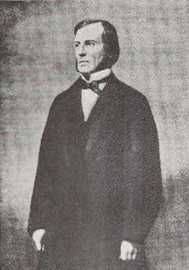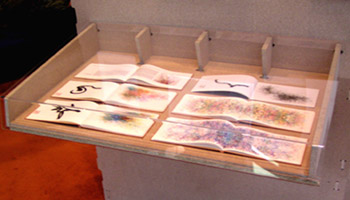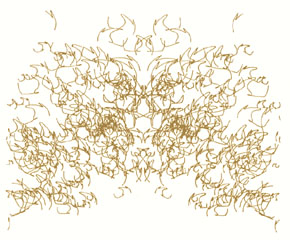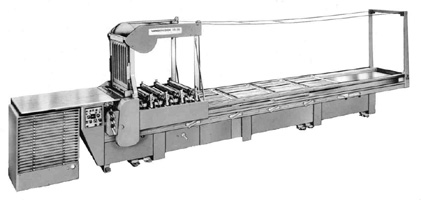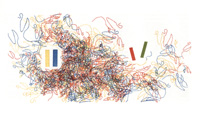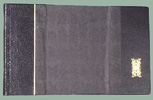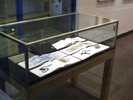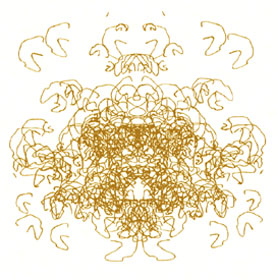main menu | site map | search | contact | copyright Derivation of the laws is Chapter III from George Boole's Investigation of the laws of thought . . .(1847) with a Statement and illustrations by Roman Verostko and a Preface by Roger Malina. Saint Sebastian Press, Minneapolis, 1990. ISBN: 1-879508-08-7
George Boole (1815-1864)
portrait source:
George Boole An Investigation of the Laws of Thought.
Dover Edition (1958, NY).
This 19th Century thinker, who developed ways of expressing logical processes using algebraic symbols, is considered the father of symbolic logic. His contributions underlie the development of switching theory essential for computing circuitry and thus the digital revolution in the 20th Century. The gating logic familiar to us in internet search engines bears his name as a "Boolean" search because it employs "Boolean" algebra.
Six edition examples on display at Ars Electronica, Linz, 2003.
The limited edition of 125 copies, bound in leather, was pulled by hand at the St. Sebastian Press in Minneapolis in 1990. Each copy has original, "one of a kind", front and end pieces with pen and brush plotted drawings executed in the artist's studio. Other illustrations were pulled with line cut plates made from original pen plotted drawings. The work was also issued in a reproduction paperback version based on the original type setting and plotter drawings (February 1991, ISBN 1-879508-07-9). The press is no longer active. The artist retains a limited number of copies of each edition. © Roman Verostko
Ornamental devices found on the text pages
were made from algorithmic pen plotted drawings.Frontispieces & Endpieces for this edition:
Below: Four out of 125 books opened to their respective frontispiece pages. These are 4 of the family of 125 original pen and brush drawings created as frontispieces. These were bound into the limited edition. Open book size: 6" by 20". (click images for larger view)

Frontispiece, #9, 1990, Open: 6" by 20",
algorithmic brush and pen ink drawing.Frontispiece, #82, 1990, Open: 6" by 20",
algorithmic brush and pen ink drawing.
Frontispiece #75, Open: 6" by 20",
algorithmic brush and pen ink drawing.Frontispiece #74, Open: 6" by 20",
algorithmic brush and pen ink drawing.Frontispieces & End pieces. For this project the front and end pieces were all generated from the same "parent code" yielding unique forms for each book in the edition. Each drawing, "one of a kind", was drawn or brushed, stroke for stroke with a pen plotter driven by the artist's software (parent code). Two families of form, 125 originals in each, introduce a radically new procedure in "post mechanical" reproduction. This edition (1990) may be the first instance where an algorithmic improvisational series of original drawings was created for a bound limited edition. This form-generating procedure will undoubtedly have a profound impact on graphic arts in the 21st Century .
Below: Four out of 125 books opened to their respective end piece pages.
These are 4 of the family of 125 original pen and ink drawings created as
end pieces. The drawings were "tipped" into the limited edition.
Open book size: 6" by 20".End piece, #14, 1990
End piece, #79, 1990

End piece #66, 1990

End piece #71 All algorithmic procedures and parameters for the front and end pieces were created and monitored by Roman in his studio. For each brush stroke an interactive brushing routine paused the procedure and requested a brush for the plotter’s drawing arm. For this project, Alice Wagstaff, Roman's wife, assisted in monitoring pen plotters in Roman's absence. She also became expert at loading brushes for the drawing arm and monitoring the ink pens.
Typography, Printing and Binding
A four color Vandercook, "Vandy", proof press
with four double page plates that were used for
color proofs. Proof presses like this one, no longer
manufactured, have been adapted by some
artists for limited letterpress editions. Michael
Tomaszewski pulled the George Boole edition
with this kind of press.Printing & Typography: Michael Tomaszewski. While the front and end pieces were original one-of-a-kind works the internal color illustrations accompanying the text were reproductions printed in four colors using four zinc line-cut plates. Roman created algorithmic pen and ink drawings for these interior illustrations. Using the master code he cloned each color in a separate drawing using black ink for each color. From these drawings four line cut zinc plates were made for each color illustration. With the "Vandy" press Michael printed all four colors with a wet impression in the same run. His skill, coupled with unusual artistic sensibility, achieved superb register and color with this seemingly cumbersome technology (see page examples below).
Text page and illustration, 1990. Open: 6" by 20" . (click each page for larger image)
Letterpress with cast type for text and 4 line cut zinc plates for the illustration.
Illustration facing page 15. The 4 zinc
plates for this letterpress illustration were
made from algorithmic pen and ink drawingsMichael set the text in Gill Sans which he had cast at M&H Type of San Francisco. The same type setting, layout, and plates were used for the paperback black and gold reproduction edition.
Binding: Michael Norman. Leather bindings by Michael Norman included 100 regular; 20 deluxe Moroccan with gold imprint and 5 artiste livre (never completed).
The Pathway Studio Seal, Xiao Jing Zhai, was carved by Wang Dong Ling, a Shufa Master from Hangzhou, PRC.
Deluxe binding. Gold stamp device from
an algorithmic pen drawing, 6" by 10", 1990.
Reproduction edition printed by Twin City Litho
Saint Sebastian Press, 1990
Ornament page, verso, 10" by 6"
Print, line cut plate from algorithmic pen drawingDisplay of book examples in an exhibition.
Ornamental device facing title page.
These devices were printed with line
cut zinc plates made from
algorithmic pen plotted drawings.
Artist's Statement in "The Derivation of the Laws. . ."
The following Statement was published in the limited edition of George Boole's Derivation of the Laws which is Chapter III, from Boole's classic work: An Investigation of the Laws of Thought.. (Macmillan, 1854).
STATEMENT. Early in this century a number of artists became intensely interested in unfolding a universe of visual form which did not "re-present" the world we see around us. Wassily Kandinsky strove to create "improvisations" based on "inner necessity", something like the structure of harmony in music. Paul Klee observed that he wished to "make visible the invisible" - perhaps the process of a flower blooming. And Piet Mondrian sought a "dynamic equilibrium" through the visual equivalence of opposites - an opposition he observed most profoundly in the relationship of the vertical and the horizontal elements in the landscape. These and many others - Frantisek Kupka, Kasimir Malevich, Barbara Hepworth, and the pioneering constructivist brothers Naum Gabo and Antoine Pevsner - all shared one thing in common - they sought to make visible a reality which was not visible.
Each in his personal way searched for forms which some have called the "new reality" - a world of forms without reference to the visual vocabulary of our everyday world. Terms such as "non-objective art", "concrete art" and more generally "abstract art" have been used to refer to this work. Within the first generation of these artists, we have experienced many marvelous moments: recall the lyrical biomorphic forms in the sculpture of Jean Arp - the vibrating power of interacting colors in the work of Joseph Albers and Victor Vasarely - and the expressive wonder in the organic worlds sculpted by Isamu Noguchi.
Within the past fifteen years, experiments with worlds of unseen visual form have crossed a new threshold. The pioneers who opened our eyes to such forms have been mathematicians and physicists whose images of complex dynamic systems have amazed the discoverers themselves.
The hidden worlds of visual adventure were either unknown or not able to be visualized before the advent of computers. One world filled with visual adventure, which lay largely unseen before computers, was brought to visualization through the work of Benoit Mandelbrot (Note 2). Surprisingly this hidden world emerged from the need for a geometry for measuring and describing the forms of nature. How do we describe mathematically the shape of a cloud, a coast line, or a mountain? Not with the cones and spheres of Euclidian geometry! Mandelbrot identified a new geometry of fractal shapes. This geometry, aided by a computer, can be used to visualize the form of the phenomenon it defines. This revolutionary new geometry, still in its infancy, has seized the imagination of many artists involved with computer graphics.
For now, it is clear that geometries, both old and new, coupled with the power of the computer, have sown the seeds for a revolution in the arts. The next generation will see magnificently articulated improvisations as artists learn how to use dynamic iterative techniques. Both the frontispiece and the end-piece in this book are hard copy examples of such improvisation.Each is an original "one of a kind" in a "family" of forms. For example, the brush stroke, in the frontispiece, presents the key shape which controls all the other "self-similar" strokes. No other book in this edition has a frontispiece evolved from the same shape Thus the final form is unique in every book. On the other hand, every frontispiece, sharing the same parameters and instructions, belongs to the same form family - each has a true "familial" resemblance to every other work in the edition. (Note 1)
There are many remarkable analogues between computing processes and biological processes, e.g. software generations, computer viruses. We can expect these analogies to become more apparent as computers evolve further. We assume that the "rulebook" in our universe is the same for every information processing system whether it be the mind of a human or a chimpanzee, an abacus or a Disk Operating System (DOS).
This "rulebook" fascinated George Boole. He was convinced that if the laws of logic "are really deduced from observation, they have a real existence as laws of the human mind independently of any metaphysical theory . . .". He sought to identify those rules of thought and give them algebraic expression.
In Proposition IV he identified "the fundamental law of thought" as Aristotle's principle of contradiction - that "it is impossible for any being to possess a quality and at the same time not to possess it" (Note 4). George Boole argues from its algebraic equivalent that "what has been commonly regarded as the fundamental axiom of metaphysics is but the consequence of a law of thought, mathematical in its form."
From this foundation he evolved a symbolic logic for the "essential laws of human language". He achieved the first successful application of algebraic methods to logic, an achievement which provided the foundation of all subsequent developments in the field. "Boolean" Logic, refined by his successors and essential to switching theory, has been the cornerstone for developing the circuitry and software for the modern computer.
If George Boole were living today he would stand in wonder and amazement pondering the magnificent machine language that has evolved since the publication of the "Laws" in 1854. I think especially that he would be transported to near ecstasy seeing the binary 1's and 0's in computer assembly language which symbolize the "on' and "off" bits. This is his Proposition IV evolved into a machine language that controls the electronic circuits in everything in our daily world from cash registers, airplanes, and washing machines to Cray supercomputers.
The illustrations in this book have evolved from procedures made possible by Boolean logic. For several illustrations I adjusted my algorithms to use terms from Boole's symbolic logic for the graphic improvisation. In those cases the 1's and 0's were distributed randomly around a center of attraction. The visual effects are intended to suggest the dynamism inherent in logical systems. It is a tribute to Boole who perceived the value of a symbolic language of logical equivalence in advance of computer languages.
As a final note I want to place this work in historical context. In the early 15th Century Filippo Brunelleschi developed linear perspective and Leon Battista Alberti documented its theory and practice in his work "Della Pittura" (1435). The perspective of the 15th century was more than a re-tread of the perspective practiced in the Roman empire. Alberti's treatise emerged along with the growth of empirical observation as a learning method and an interest in the study of optics as a key to that learning.
Furthermore, Alberti believed that mathematics and logical order were essential for the practice of art. Subsequent development in the theory and practice of perspective altered the art of western culture. Indeed, Renaissance perspective provided the tools of visualization essential for the development of modern western civilization.
I think that we stand at a similar threshold today as we face the future. The computer provides the artist with a seemingly limitless power to transform and improvise. And, like renaissance perspective it provides us with a new window on our world - one that is altering the way we perceive that world.
Over the years I have gained a respect (and even affection) for the machines I use. My plotters, named Alberti and Brunelleschi, are with my computer, my excellent companions in exploring these new perspectives. (Note 3)
They help me explore visual analogues of probability, forms which were hidden from view before we had these machines. Through the computer we have gained access to a visual domain filled with mystery, a domain that was invisible before. For many the energy and growth patterns of these forms echo processes lying at the core of the unfolding universe. My work explores a faint echo of this cosmic landscape. For me, the computer and its companion plotters, provide a new pathway to "making visible the invisible".
Now, in the summer of 1990 we recognize that electronic art is still in its infancy. But, as in the early 15th century, there are artists now wrestling with the problems of the transformation and creation of art forms with computers. The new geometries and new technologies will surely bring a revolution as we approach the next century. This book is a tribute to George Boole whose work helped make this new adventure possible.
Roman Verostko, Minneapolis, 1990
Source for the text by George Boole: CHAPTER III. "DERIVATION OF THE LAWS OF THE SYMBOLS OF LOGIC FROM THE OPERATIONS OF THE HUMAN MIND", from AN INVESTIGATION OF THE LAWS OF THOUGHT ON WHICH ARE FOUNDED THE MATHEMATICAL THEORIES OF LOGIC AND PROBABILITIES by George Boole, L.L.D., first published in London in 1854 by Macmillan.
----------------------------------------------------------------------------------
Note 1. Original, "one of a kind", works for the frontispiece and end-piece were plotted in the studio for the "hand pulled" letterpress edition only. Special reproduction works were created for the litho paperback edition.
Note 2. B. Mandelbrot The Fractal Nature of Geometry (NY: 1982) which is a revision of Fractals: Form, Chance and Dimension (1977).
Note 3. Since 1990 the studio, having grown to a network of workstations, has become more of a "digital scriptorium" with the plotters working as digital scribes. Even so, the artist "companion-like" atmosphere prevails.
Note 4. The original Greek text was noted in George Boole's edition and also in the limited edition (click here for Greek text). To pay for his education George Boole tutored students in classical languages. It is remarkable that his knowledge of the classics provided the keystone for the Boolean operators that lie at the heart of electronic logic circuits!
Locations of originals in libraries & public collections:
Ars Electronica Center, Linz, Austria
Block Museum, Northwestern University, Evanston. IL, USA
Duquesne University, Pittsburg, Pa.
Minneapolis College of Art & Design
Pratt Institute, Brooklyn, NY
St. John's Abbey, Collegeville, MN
St. Vincent Archabbey, Latrobe, PA
Tama Art University Museum, Tokyo, Japan
Victoria and Albert Museum, London, UK
Walker Art Center, Minneapolis, MN
ZKM, Zentrum fur Kunst und Medientechnologie, Karlsruhe, Germany
main menu | site map | search | contact
